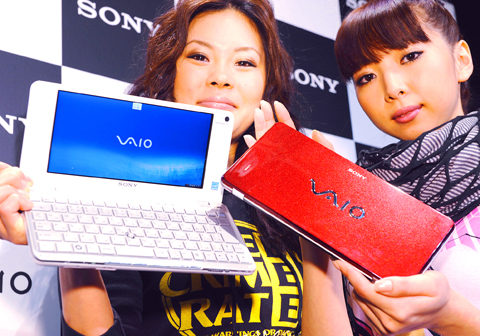Japanese consumer electronics maker Sony Corp yesterday introduced its high-priced alternative to the growing demand for netbooks — the VAIO P — at a product launch held simultaneously in Taipei, Tokyo and Las Vegas’ Consumer Electronics Show.
The VAIO P marks the multinational conglomerate’s foray into pocket PCs, as the company struggles to carve out a market niche to counter the netbook PC attack.
Taipei-based research and consulting group Topology Research Institute (拓墣產業), in a report released yesterday, forecast that global netbook PC shipments would reach between 27.25 million and 32 million this year.

PHOTO: AFP
In response to Topology’s report, Hiroyuki Oda, general manager of Sony Corp’s VAIO business group, told reporters yesterday: “We acknowledge the netbook demand, but we will not enter the low-priced netbook market.”
Oda said that since its founding in 1946, Sony has always been at the forefront of the consumer technology revolution, including the introduction of the concept of music-on-the-go with the launch of the Walkman.
“Our focus has always been on creating value through design, innovation and specialization. Without specialization, there would have been no VAIO,” Oda said.
Oda stressed that the 8-inch VAIO P is a pocket PC — and not a netbook.
However, Taipei-based researcher Market Intelligence Center (MIC) defines netbook PCs as products with display sizes ranging from between 7 inches and 10.2 inches, while notebook PCs are equipped with displays 10.4 inches and above. In short, the VAIO P falls into MIC’s netbook category in terms of display size.
Still, some industry watchers classify netbooks as low cost, mini-notebooks that retail between US$300 and US$400 per unit. The VAIO P series are priced between NT$26,800 and NT$36,800 (US$800 and US$1,100).
Sony is not worried that the VAIO P might cannibalize its existing ultra-portable TT and Z notebook series, since these two lines are even more distinctly priced than the P, with 11-inch and 13-inch displays respectively.
In the near term, the company has no plans of following netbook vendors’ popular tactic of collaborating with local telecom operators to promote their product through bundled sales (netbook + telecom subscription plan), Oda said.
Sony’s new pocket PC, which includes all the latest notebook add-ons, runs on Intel’s Atom Z processor and features an “Instant On” technology that allows users to boot up one program (such as the Internet browser) instead of running the entire operating system.
This same “Instant On” technology, developed by Taiwanese software company Device VM Inc (達維飛碼 ), has attracted a lot of interest at the Consumer Electronics Show in Las Vegas, Topology said.
Netbook vendors such as Asustek Computer Inc (華碩), Acer Inc (宏碁) and Hewlett-Packard Co are embracing this time-saving platform, and rolling out quick-start netbook PCs. Even Lenovo Group Ltd (聯想) recently included “Instant On” in its latest netbook line, Topology said yesterday.
As the economic downturn spreads, global demand for consumer PCs is also slowing. Oda yesterday did not talk about sales forecasts for the VAIO P, saying Sony was still observing consumer response to the new product.
“Although the global financial crisis is hurting sales worldwide, Asia Pacific remains a strong area of growth for us, whereas developed countries such as US, Europe, and Japan are showing signs of a slowdown,” Oda said.

WEAKER ACTIVITY: The sharpest deterioration was seen in the electronics and optical components sector, with the production index falling 13.2 points to 44.5 Taiwan’s manufacturing sector last month contracted for a second consecutive month, with the purchasing managers’ index (PMI) slipping to 48, reflecting ongoing caution over trade uncertainties, the Chung-Hua Institution for Economic Research (CIER, 中華經濟研究院) said yesterday. The decline reflects growing caution among companies amid uncertainty surrounding US tariffs, semiconductor duties and automotive import levies, and it is also likely linked to fading front-loading activity, CIER president Lien Hsien-ming (連賢明) said. “Some clients have started shifting orders to Southeast Asian countries where tariff regimes are already clear,” Lien told a news conference. Firms across the supply chain are also lowering stock levels to mitigate

Six Taiwanese companies, including contract chipmaker Taiwan Semiconductor Manufacturing Co (TSMC, 台積電), made the 2025 Fortune Global 500 list of the world’s largest firms by revenue. In a report published by New York-based Fortune magazine on Tuesday, Hon Hai Precision Industry Co (鴻海精密), also known as Foxconn Technology Group (富士康科技集團), ranked highest among Taiwanese firms, placing 28th with revenue of US$213.69 billion. Up 60 spots from last year, TSMC rose to No. 126 with US$90.16 billion in revenue, followed by Quanta Computer Inc (廣達) at 348th, Pegatron Corp (和碩) at 461st, CPC Corp, Taiwan (台灣中油) at 494th and Wistron Corp (緯創) at

NEGOTIATIONS: Semiconductors play an outsized role in Taiwan’s industrial and economic development and are a major driver of the Taiwan-US trade imbalance With US President Donald Trump threatening to impose tariffs on semiconductors, Taiwan is expected to face a significant challenge, as information and communications technology (ICT) products account for more than 70 percent of its exports to the US, Chung-Hua Institution for Economic Research (CIER, 中華經濟研究院) president Lien Hsien-ming (連賢明) said on Friday. Compared with other countries, semiconductors play a disproportionately large role in Taiwan’s industrial and economic development, Lien said. As the sixth-largest contributor to the US trade deficit, Taiwan recorded a US$73.9 billion trade surplus with the US last year — up from US$47.8 billion in 2023 — driven by strong

ASE Technology Holding Co (ASE, 日月光投控), the world’s biggest chip assembly and testing service provider, yesterday said it would boost equipment capital expenditure by up to 16 percent for this year to cope with strong customer demand for artificial intelligence (AI) applications. Aside from AI, a growing demand for semiconductors used in the automotive and industrial sectors is to drive ASE’s capacity next year, the Kaohsiung-based company said. “We do see the disparity between AI and other general sectors, and that pretty much aligns the scenario in the first half of this year,” ASE chief operating officer Tien Wu (吳田玉) told an